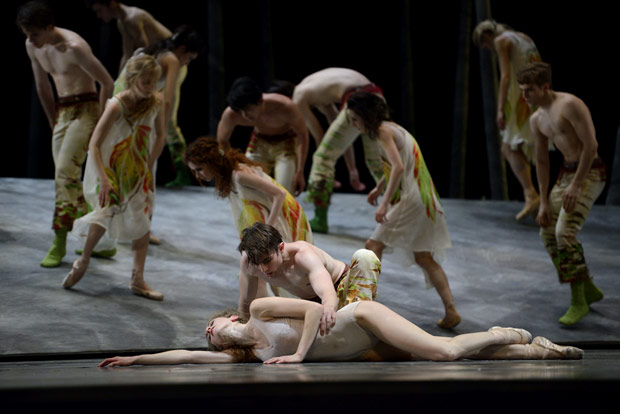
© Erik Tomasson. (Click image for larger version)
San Francisco Ballet
Program 3: Guide to Strange Places, Beaux, The Rite of Spring
San Francisco, War Memorial Opera House
26 February 2013
www.sfballet.org
The 29th of May 1913 is what some might call the pivotal moment in the development of modern music and dance. Now a century since the famous riot at the Théâtre des Champs-Elysées in Paris during the premiere of Igor Stravinsky’s Le Sacre de Printemps (the Rite of Spring) choreographed by Vaslav Nijinsky for Diaghilev’s Ballets Russes, we can see just how much progress was made in the first five decades afterward. But that growth has reached a plateau in the last fifty years, qualitatively, but not quantitatively.
Choreographers seem to regard utilising this score as a rite of passage, that grappling with this rhythmically complex music confers some certificate of accomplishment. According to the Roehampton University of Surrey’s database of dance pieces set to Stravinsky’s compositions, there are a total of 185 versions listed, 21 of them made before 1963, and 164 after. The choreographers range from Mary Wigman, Martha Graham, Pina Bausch and Yvonne Rainer to Maurice Béjart, Kenneth MacMillan, Paul Taylor and Hans van Manen, not to mention the lesser-known and the totally obscure ones.
For the 100th anniversary of Stravinsky’s monumental work, anyone and everyone has decided to commemorate it either with symphonic concerts, revivals of previously staged ballets or newly choreographed ones. Celebrating this ritual sacrifice yields up a fertile field of performances, including some probably sprouted from genetically modified seeds.
Carrying on the theme introduced by Hamburg Ballet’s performance of Neumeier’s “Nijinsky” a couple of weeks ago with its references to the Rite of Spring, San Francisco Ballet’s own Choreographer-in-Residence, Yuri Possokhov, now premieres his own version. Before the curtain even rises I know I’m up against the recurring problem of maestro Martin West’s conducting. The overture doesn’t lure me in and as the piece progresses I am more and more dismayed. There is no driving pulse, no incisive, rapier-edged definition of the constantly shifting rhythms, no playing the wind instruments off against each other, no exhilarating inner tension. I know it’s not the orchestra’s fault because they played brilliantly under Simon Hewett for “Nijinsky.”

© Erik Tomasson. (Click image for larger version)
Possokhov’s ballet is a mixture of mostly good choices with a few that seem rather odd to me. The somber stark set of birch tree trunks surrounding a ramp rising to the back, designed by Benjamin Pierce, certainly evokes the ominous brutality about to unfold. Sandra Woodall’s costumes for the bare-chested men are earth-toned and have a primitive flavour. The costume for The Elders, an enormous piece of painted stretch fabric that engulfs both dancers (the excellent Garen Scribner and James Sofranko) from torso to knees, makes them appear like a centaur with two heads or Doctor Dolittle’s pushmi-pullyu. The effect is quite startling and adds extra dimensions of meaning to their role, that of the wise ones wrapped in a gigantic animal hide, so that whatever they decree is unanimous and supernatural.
On the other hand, the women’s costumes are of another time and place. The sleeveless knee-length tunics of sheer white chiffon painted with forest designs in green, brown and orange are anachronistic at best. First of all, the white is too bright and clean amidst the earthiness, and secondly, the fabric is far too lightweight and airy. An ivory or flesh-colored heavier weight cotton gauze with cruder embellishment would be better suited to the overall design. I understand the need for the transparency, as the women sometimes draw the hems of the dresses up over their heads while dancing, depriving them of any individuality as they become mere sexual objects in this annual fertility rite.
The choreography itself is also a peculiar amalgam. Most of the time it is earthbound, powerfully aggressive and contorted in its folkdance-like stomping, but because the women wear pointe shoes, suddenly a few classical ballet steps will appear jarringly out of context. Yet, I do like the sharpness of attack the shoes give the women’s feet in other movements. Another forceful element is the use of poles, first by the Elders, and then by the men who carry the Chosen One around the stage hung by her limbs across two sets, one high and the other low. This image is further magnified by the rest of the dancers beating out rhythms on the floor with sticks. The closing image of the men bending four trees down to the floor and tying the arms and legs of the Chosen One to them, then releasing them to spring upright on the final chord is absolutely gut-wrenching in its horror.
Both Jennifer Stahl as the Chosen One and Luke Ingham as her partner in the ritual mating dance are excellent technically and emotionally, and the entire cast dances with conviction and cohesiveness.
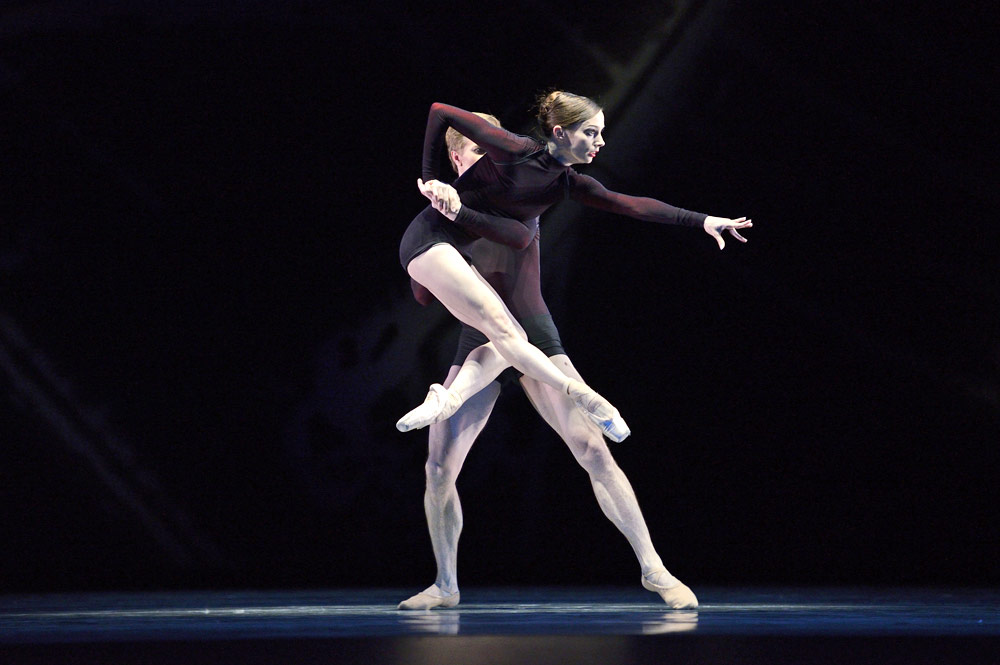
© Erik Tomasson. (Click image for larger version)
The program opened with Ashley Page’s Guide to Strange Places which premiered last season. The choreography still doesn’t sit well on the dancers. It has the disjointed feeling of steps strung together without much consideration for creating entire movement phrases and with few exceptions the dancers’ expressions range from dead pan to vacant. The whole affair is rather non-stop with Page cramming in as many steps as counts in the music, leaving no breathing room in any sense of the term. Fortunately, Maria Kochetkova, Pascal Molat, Kimberly Braylock, Francisco Mungamba and Lonnie Weeks find a way to infuse their own parts with their interpretive visions.
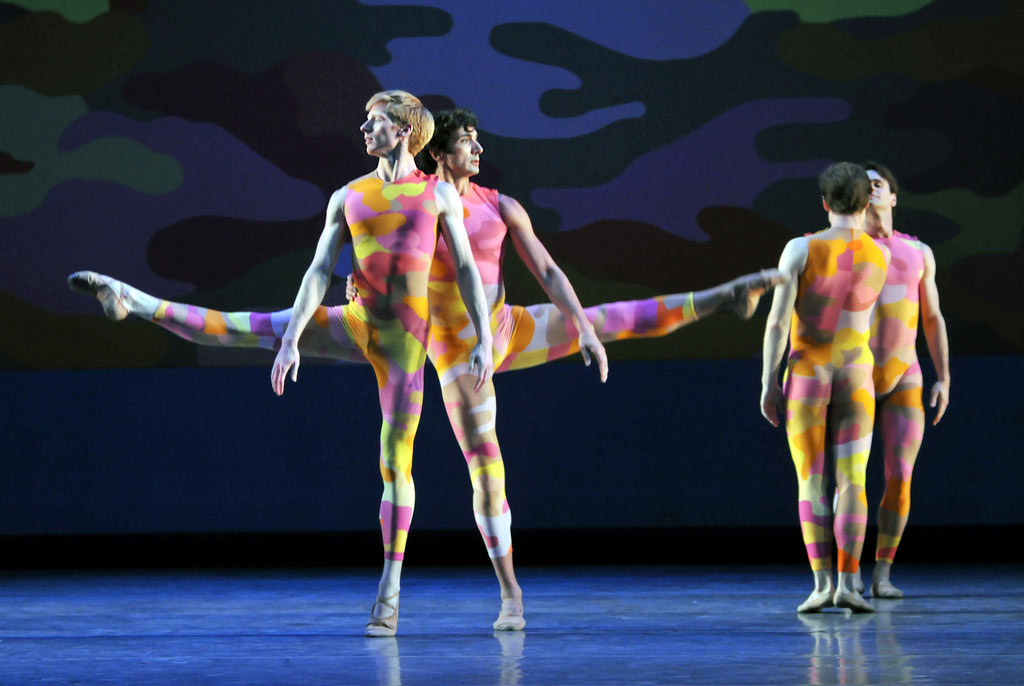
© Dave Morgan. (Click image for larger version)
Mark Morris’s Beaux, also new last season, has the odd juxtaposition of the rather formally constructed choreography which reflects the Martinů harpsichord music against the pink camouflage costumes and backdrop designed by Isaac Mizrahi. Ruben Martín Cintas and Vito Mazzeo provide pure poetry with their emotional expression that suggests they should be dressed for a Mozartean drawing room instead of a pastel Desert Storm.
Program 3 repeats March 2 at 2 and 8 pm, March 8 at 8 pm, March 10 at 2 pm.












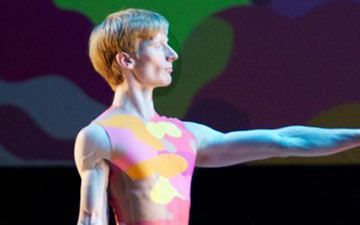
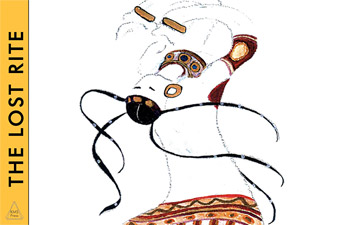

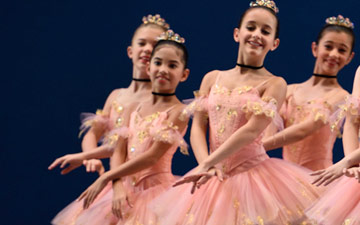

You must be logged in to post a comment.